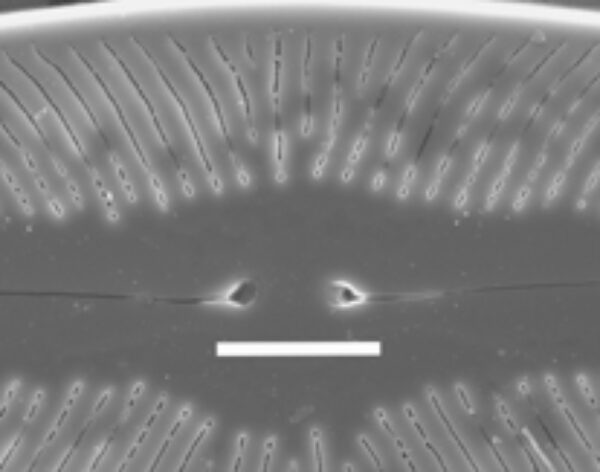Navicula volcanica
-
Category
-
Length Range100-176 µm
-
Width Range30-37 µm
-
Striae in 10 µm6 in the center of the valve, 8 at the ends
-
Reported AsNavicula ludloviana (Diatoms of the United States)
-
ContributorLoren Bahls, Marina Potapova - Nov 2011
-
ReviewerMarina Potapova - Nov 2011
Identification
Description
Valves are broadly rhombic with rounded apices. The axial and central areas are moderately wide, one-third to one-half the valve width, together forming a narrow lanceolate shape with a tumid center. The central area is rhombic, surrounded by alternately long and short striae. The raphe is lateral and somewhat bowed, concave to the primary side of the valve. The proximal raphe ends are inflated and tipped slightly to the secondary side. The terminal raphe fissures are shaped like question marks. Striae are curved and strongly radiate. Internally, the striae are within deep grooves, 6–8 in 10 μm. Areolae number about 28 in 10 μm. Internally, the areolae are apically elongated and occluded by hymens. The external openings of the areolae are small and fused into a narrow slit on the external valve surface. Cells are solitary with two plate-like chloroplasts lying along the girdle on each side of the valve.
Autecology
To date, Navicula volcanica has been recorded from two adjacent headwater streams in the Cascade Mountains of Oregon: North Umpqua River and the upper Clearwater River. Measured pH values in these two streams range from 6.7 to 7.7 and conductivity values range from 38 to 61 µS/cm.
-
Size Range, µm3
-
Motility
-
Attachment
-
Habitat
-
Colony
-
Waterbody
- Learn more about this
Original Description
Valves broadly rhombic with rounded apices. Length 100–176 μm, width 30–37 μm. Axial and central areas moderately wide, one-third to one-half the valve width, together forming a narrow lanceolate shape with a tumid center. Central area rhombic, surrounded by alternately long and short striae. Raphe lateral and somewhat bowed, concave to the primary side of the valve. Proximal raphe ends inflated and tipped slightly to the secondary side. Terminal raphe fissures shaped like question marks. Striae curved, strongly radiate, structured internally as deep grooves, 6–8 in 10 μm. Areolae about 28 in 10 μm. Internally, areolae apically elongated, occluded by hymens. External areolae openings small and fused into a narrow slit on external valve surface. Cells solitary with two plate-like chloroplasts lying along the girdle on each side of the valve.
-
AuthorBahls and Potapova 2015
-
Length Range100-176 µm
-
Width30-37 µm
-
Striae in 10µm6-8
Citations & Links
Citations
-
Publication Link: 10.11646/phytotaxa.218.3.4
Links
-
Index Nominum Algarum
Updates
Apr 18, 2024 - Correction of taxon name
This taxon was originally posted on Diatoms of the US as Navicula ludloviana in 2011. Later, the taxon was examined further and found to be a new taxon. It was described as N. volcanica Bahls and Potapova 2015. The text on this taxon page was adjusted to reflect the change. - S. Spaulding
Cite This Page
Bahls, L., Potapova, M. (2011). Navicula volcanica. In Diatoms of North America. Retrieved April 18, 2024, from https://diatoms.org/species/navicula_volcanica
Responses
The 15 response plots show an environmental variable (x axis) against the relative abundance (y axis) of Navicula volcanica from all the stream reaches where it was present. Note that the relative abundance scale is the same on each plot. Explanation of each environmental variable and units are as follows:
ELEVATION = stream reach elevation (meters)
STRAHLER = distribution plot of the Strahler Stream Order
SLOPE = stream reach gradient (degrees)
W1_HALL = an index that is a measure of streamside (riparian) human activity that ranges from 0 - 10, with a value of 0 indicating of minimal disturbance to a value of 10 indicating severe disturbance.
PHSTVL = pH measured in a sealed syringe sample (pH units)
log_COND = log concentration of specific conductivity (µS/cm)
log_PTL = log concentration of total phosphorus (µg/L)
log_NO3 = log concentration of nitrate (µeq/L)
log_DOC = log concentration of dissolved organic carbon (mg/L)
log_SIO2 = log concentration of silicon (mg/L)
log_NA = log concentration of sodium (µeq/L)
log_HCO3 = log concentration of the bicarbonate ion (µeq/L)
EMBED = percent of the stream substrate that is embedded by sand and fine sediment
log_TURBIDITY = log of turbidity, a measure of cloudiness of water, in nephelometric turbidity units (NTU).
DISTOT = an index of total human disturbance in the watershed that ranges from 1 - 100, with a value of 0 indicating of minimal disturbance to a value of 100 indicating severe disturbance.

Navicula volcanica
- Striae strongly radiate throughout
- Axial area broad
- Raphe distinctly bowed
- Striae finely lineolate and broad
- Proximal raphe ends expanded
Valves are large. The axial area widens near mid-valve. The central area is rhombic. The raphe branches are distinctly bowed and the proximal ends are large and bulbous. The striae are lineolate and strongly radiate throughout.
 Diatoms of North America
Diatoms of North America








